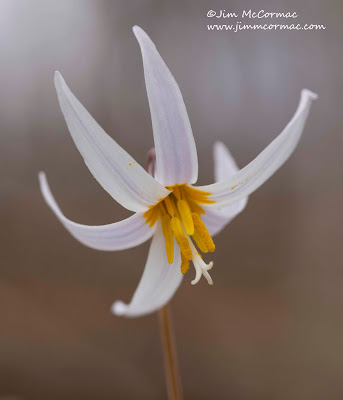Bloodroot (Sanguinaria canadensis)/Jim McCormac
Mild winter triggers early blooming of spring wildflowers
Columbus Dispatch
March 19, 2023
March 19, 2023
NATURE
Jim McCormac
Jim McCormac
Tomorrow is the official first day of spring.
March 20 is the spring equinox, when the sun is directly above the equator and day and night are of equal lengths.
Plants (and birds and most other animals) pay this celestial milestone no heed. Commencing in early February, the wildflowers respond to ever-lengthening daylight. First up is the skunk-cabbage, which springs from its swampy haunts while ice and snow are still a thing. This botanical oddity counters wintry weather with thermogenesis: the ability to produce its own heat. Flowers and pollen are present by mid-February.
Last February was especially meek in much of Ohio, with little snow and often mild temperatures. Rising soil temperatures trigger the appearance of wildflowers, and many awakened early this year. Needing a botanical fix, I headed to the Ohio River Valley on Feb. 26. My core destinations were two amazing sites owned by the Arc of Appalachia, a land trust that protects some of Ohio’s most significant natural areas.
First up was the Chalet Nivale Preserve in northwestern Adams County. Nivale (ny-val-ee) means "snowy" and refers to the scientific name of the snow trillium: Trillium nivale. The preserve harbors a massive population of this rare plant, which is only known in about a dozen of Ohio’s 88 counties. Most populations are highly localized, widely scattered and often small in size.
Plenty of trillium were in bloom by the time of my visit, the earliest I have ever seen them. Less obvious but equally interesting were the flowers of a spindly shrub, American hazelnut. Its long dangling spikes of male flowers are conspicuous, but the bigger visual treat are the tiny scarlet female flowers. They are only a few millimeters across and resemble colorful sea anemones upon close inspection.
From there, it was on south, to a spectacular east-facing bluff overlooking the Ohio River near the town of Manchester. The Arc of Appalachia owns a 300-acre preserve here known as the Ohio River Bluffs. This is the first place that I know of in Ohio where one can get their end-of-winter wildflower fix.
Even on the early date of Feb. 26, I saw over a dozen wildflower species in bloom. A tiny parsley aptly dubbed harbinger-of-spring was everywhere. A whopper is a few inches in height, yet they push through the leaf litter to present salt-and-pepper-colored flower umbels to the late winter sun. Ghostly white trout lilies, their pale flowers appearing to levitate low over the forest floor, were everywhere. This is our earliest native lily to flower.
Evidence of the rapidity of wildflower growth was a bloodroot, one of only two native poppies in the state. On my way out of the preserve, I noticed one in full bloom, its flower still unfurling. I’m confident it wasn’t there when I hiked past two hours earlier.
Ohio River Bluffs is noted for huge carpets of bluebells, but the floral show doesn’t usually take the stage until late March into early April. This year, many bluebells were already up and some were even in flower. Other early blooms were cut-leaved toothwort, hepatica, rue-anemone, and yellow harlequin.
By now, nearly a month later, far more wildflowers are out, including in the Columbus area. Good places to hunt them include Battelle Darby and Highbanks metro parks. For those in northern lands like Cleveland, Mansfield and Toledo, take hope. Spring rolls northward at about 17 miles a day, and it won’t be long until the floral show hits your areas.
Naturalist Jim McCormac writes a column for The Dispatch on the first, third and fifth Sundays of the month. He also writes about nature atwww.jimmccormac.blogspot.com.
White Trout Lily (Erythronium albidum)




%20copy.jpg)
No comments:
Post a Comment